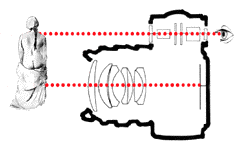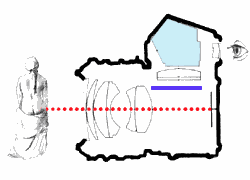22
2013Camera Types {Beginner Photography Class}
Now that we know how a camera works in an oversimplified way, lets learn about the different camera types. If you’re a photographer/crazy gear nut, please overlook my gross oversimplification. I’m trying not to scare the newbies off! (Graphics are credited to this site)
Not including our pinhole camera :-p, there are three basic camera types: point and shoot, SLR, and SLT/mirrorless. I’m going to give you a quick explanation of each camera type. Then, we’ll explore the pros and cons the camera types.
Camera Types
Point and Shoot

In a point and shoot, what you see in the viewfinder isn’t exactly what will be captured.
Back in the film days, these were known as rangefinders. In a point and shoot, when you look through the view finder (or lcd screen) you’re not seeing exactly what’s going to be shot through the lens. You are instead looking through something like the peep hole in hotel doors. Therefore you’re seeing something in close range to what will be shoot. Rangefinder, got it? This not seeing exactly what you’re shooting is called Parallax Error (a piece of information suitable for trivial pursuit…ahem). What you really need to know is that the closer you are to your subject, the worse that error will be. You might cut off the tops of heads or other such detail. You need to be aware of this Parallax Error if you’re shooting with a point and shoot and learn to compensate when needed.
Pros of a Point and Shoot
- Inexpensive- or a price range for everyone
- Lightweight
- Super Portable (fits in a pocket or purse)
- May be embedded in your cell phone 😉
- Usually has a visual dial/menu listing of different settings (a moon for night photography, a face for portraits, a mountain for landscapes)
- Typically has a pop-up flash (and this can be a con if you use it too close or have your subject too close to a wall…)
Cons of a Point and Shoot
- Parallax Error (explained above)
- Slow response time. When you press the shutter release button and there’s a delay of around 1-5 seconds before the image is taken. This is frustrating when capturing children or sports.
- Usually can’t change lenses
- Zoom feature is often digital which means images can get pixel-y/grainy.
- Most don’t allow for full manual control.
Single Lens Reflex (SLR)

SLR cameras allow you to see the exact image that will be taken through the use of a mirror.
The Single Lens Reflex (SLR) is the type of camera you envision your professional photographer using. It’s got the fancy detachable lenses, lots of crazy settings, and it makes that satisfying click when you press the shutter release button. The click is a mirror snapping up and out of the way of the recording medium (film or your digital sensor). In the image above the mirror is the dark blue thing. The light blue area is a prism that turns the image back right side up so we’re not all confused in the optical viewfinder. In an SLR the photographer sees exactly the shot they are about to take.
Pros of the Single Lens Reflex
- Price ranges from fairly inexpensive ($200+ for used or older varieties) to extremely expensive (over $3000) depending on features and sensor size.
- With the mirror, you’re seeing exactly the spot you’re photographing
- You can manually adjust all of your settings even on the most inexpensive variety. This means you have full creative control!
- Hardly any lag time between pressing the shutter release button and the taking of the image. You don’t have to anticipate what your crazy kiddos are about to do before taking the shot; you’ll capture the moment you see or a mere 100th of a second afterward.
- Interchangeable lenses.
- Zoom is mechanical in the lenses rather than digital meaning the image quality is not reduced when zooming in.
Cons
- Heavy
- Isn’t as portable as a Point and Shoot. Likely won’t fit in your purse or back pocket. :-p
- May not come with a built in flash (again… not necessarily a bad thing)
- Good lenses can be pricey; sometimes even more expensive than your camera body itself.
- Takes a while to learn to use well. It isn’t as fool proof as a point and shoot.
- Optical viewfinder may be a bit dark.
Mirrorless Cameras or Single Lens Translucent
Mirrorless Cameras (or SLTs as Sony calls them) are the newest technology out there. You’re still looking through the lens like in an SLR except there’s no mirror. You’re literally gazing at what the sensor sees. This isn’t possible in film cameras. This also means that your viewfinder isn’t optical (a piece of glass); it’s typically tiny LCD screen. Mirrorless Camera’s can look very much like a point and shoot or just like an SLR (just without the mirror click!). Even the ones that look like a point and shoot typically have interchangeable lenses, just like an SLR.
Pros of Mirrorless Cameras
- No lag time at all between pressing the shutter and taking an image. Most of them even allow for continuous shooting (taking up to 10 images in rapid succession)
- Electronic viewfinder shows the scene exactly as the camera sees it. This is a lot different than the optical/LCD viewfinder of Point and Shoot or SLR cameras. You’re not seeing the scene as the naked eye sees it; instead, you’re seeing the exact thing that will be recorded. (Some people find this electronic viewfinder a con.)
- You can manually adjust all settings even on the varieties that look like point and shoots.
- Interchangeable lenses
- Zoom is mechanical in the lenses rather than digital meaning the image quality is not reduced when zooming in.
- Some are as portable as the Point and Shoots and have interchangeable lenses too!
Cons of Mirrorless Cameras
- Expensive! New technology comes with a price. Even the cheapest one is going to run you about $500.
- The electronic viewfinder actually draws some light away from the sensor. This mostly isn’t noticeable unless you’re shooting in darker conditions.
- Some are heavy.
- The more traditional SLR body types are not so portable.
- May not come with a built in flash (again… not necessarily a bad thing)
- Good lenses can be pricey; sometimes even more expensive than your camera body itself.
- Takes a while to learn to use well. It isn’t as fool proof as a point and shoot.
Mini Homework
Figure out what camera type you’re using! It might take a little Google work, but it shouldn’t take long!
Just because I know someone is going to ask: I use a Digital SLR, a Sony a200. It’s an entry level camera from about four years ago. I have my eye set on upgrading to Sony’s a77 SLT, but my policy is no debt so it might take me over a year to save that much and by then the full frame a99 might have come down enough in price for me to snatch it up used. 🙂 In my spare time and when I have darkroom chemicals on hand, I shoot a Canon A-1 film SLR which I still love to bits 🙂
Did you learn anything about camera types in this post? Have any ah-ha moments about why your camera does that thing that drives you nuts? Let me know in the comments!
Next week we’ll be ready to enjoy and critique your favorite images, so start sorting and editing (if applicable). I’ll be posting both my straight out of the camera shots (SOOC) and my final edits of some of my recent sessions for you to see and critique as well as hosting a link up. I can’t wait to see what you love!


A Free Beginner Photography Class @ Beautiful Newborn and Lifestyle Portraits by Quiet Graces PhotographyBeautiful Newborn and Lifestyle Portraits by Quiet Graces Photography
[…] Camera Types […]